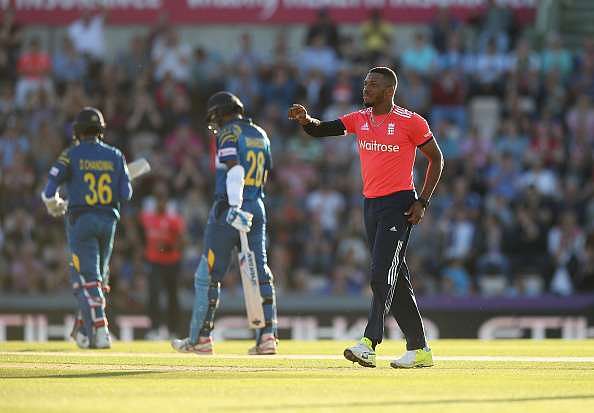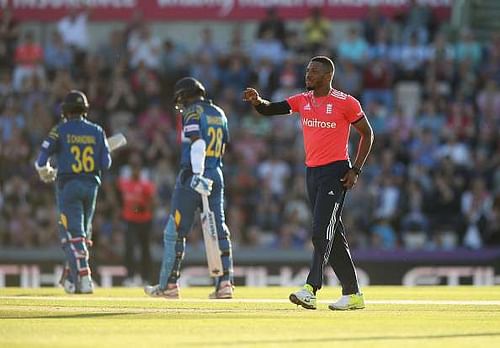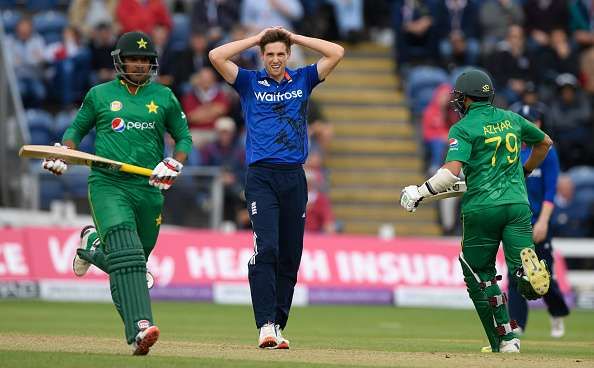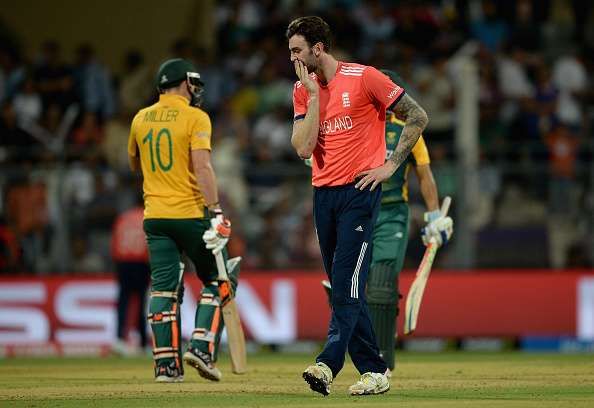
Impact of specialist fast bowlers on England's limited overs fortunes
Over the years, England has produced some fabulous fast bowlers. Right from Trueman and Statham to Botham and Willis to Anderson and Broad, England’s fast bowling arsenal has always been full of ammunition. But all these mentioned names were, and a few still are, legendary performers in test cricket. When it comes to one-day internationals, England has never really produced a fast bowler who can lay claim to being among the all-time greats, despite it being a 45-year-old format.
This can perhaps be best illustrated by the fact that in this history of limited overs cricket, only 2 England bowlers have taken over 200 wickets – James Anderson with 269 and Darren Gough with 235. It must hence come as no real surprise to cricket fans that England have never won the 50-over World Cup and, their one day record, especially since the 90s, hasn’t been particularly impressive.
This trend, though, has seen a pleasant change in the last 2-3 years. England have started producing fast bowlers who can be termed one-day specialists and their inclusion in the set-up has seen a turnaround in England’s limited overs fortunes.
Their fast bowlers earlier didn’t seem too inclined to adapt to the changing nature of the game and include a lot of variations in their repertoire, which with time became necessary, as the advent of T20 cricket and vast improvement in the quality of cricket bats meant that if as a fast bowler you start to get predictable, you’ll be smacked around.
The newer crop of fast bowlers are more open to these changes and have a lot of tricks up their sleeve. Some of the names that can be taken in this category are Chris Jordan, Chris Woakes, David Willey, Reece Topley and Mark Wood.
With the exception of Woakes who made his debut in 2011, all others have started playing for England within the last 3 years and have already made a significant impact on the team’s one-day setup.
Let’s see their numbers:
In ODIs:
Bowler | Matches | Wickets | Average | Economy | Strike Rate | Age |
Chris Woakes | 52 | 70 | 33.70 | 5.65 | 35.7 | 27 |
Chris Jordan | 31 | 43 | 35.37 | 5.95 | 35.6 | 27 |
Mark Wood | 11 | 12 | 48.16 | 5.83 | 49.5 | 26 |
David Willey | 20 | 29 | 30.31 | 5.53 | 32.8 | 26 |
Reece Topley | 10 | 16 | 25.62 | 5.31 | 28.9 | 22 |
In T20Is:
Bowler | Matches | Wickets | Average | Economy | Strike Rate | Age |
Chris Woakes | 8 | 7 | 36.14 | 9.37 | 23.1 | 27 |
Chris Jordan | 19 | 21 | 26.71 | 8.63 | 18.5 | 27 |
Mark Wood | 1 | 3 | 8.66 | 8.66 | 6.00 | 26 |
David Willey | 12 | 18 | 18.05 | 8.26 | 13.1 | 26 |
Reece Topley | 6 | 5 | 34.60 | 10.07 | 20.6 | 22 |
As we can see, barring Wood’s present ODI numbers and Topley’s T20I’s, all numbers are mostly impressive.
What these new boys bring to the table is a new set of tools and tricks that are needed in today’s limited overs cricket. They have all got their own unique skills: Jordan and Willey bowl great Yorkers at the death of an innings – who can forget that excellent super over Jordan bowled against Pakistan in November last year when he bowled yorker after yorker to restrict the batsmen to just 3 in the over!
Mark Wood has this explosive quality about him that can unsettle the best of batsmen. He can bowl at speeds in excess of 90 mph regularly and, when he produces unplayable deliveries at such pace, the batsmen are often left wondering, like Sharjeel Khan was, in the 2nd ODI of the recently concluded one-day series in England.
Reece Topley’s expertise is in the slower balls that he bowls with regularity, and those coming from a high angle (he’s 6 ft 7 in) from a left arm over the wicket angle, causes trouble to all batsmen, especially when they’re looking to go for quick runs. As a return of 16 wickets in 10 matches at an economy of 5.3 suggests, he has been fairly successful so far with his tricks.
A lot of England’s recent ODI and T20I success has been attributed to their explosive batting, and that isn’t entirely incorrect either, as in the 41 ODIs they have played since 1st January 2015, they have scored over 300 runs in an innings no fewer than 16 times, which means in almost 40% of the matches they have played. This indeed is a staggering number, but what can’t be given any lesser credit is the effort of their fast bowlers in these matches.
Take David Willey as an example, as he in my view, is the new rising star in limited overs international cricket. He made his ODI debut on 8th May 2015 and since then has played 20 ODIs thus far. Out of these 20, England has won 12 and 3 have been either tied or no-result matches, which means just 5 losses in 20 matches, that is just 25% of matches lost in which he has played.
As we saw from the table above, he has taken 29 wickets in these matches at a strike rate of less than 33, which shows the impact he has had on the fortunes of England’s one day team even since he has arrived on the scene.
England’s bowling attack earlier used to be one-dimensional, as they mostly had bowlers who played red ball cricket predominantly, as well as limited overs cricket.
The likes of Anderson, Broad, Harmison, Hoggard, Tremlett, all excelled with the red ball but did not offer a lot of variation with the white one as their bowling styles and temperament were more suited to the longest version of the game, and they also lacked the specific skill set that’s needed for limited overs matches.
Although to their credit, Anderson and Broad have fairly good limited overs stats, but over the past 2-3 years, we’ve seen their number falling off as the game has been changing at a rapid rate.
From the bowlers we have seen in the table above, only Chris Woakes is a regular member of the test team, and he too has cemented a place in the team only recently, courtesy a stellar performance in the recently concluded test series against Pakistan where he was the man of the series.
Mark Wood and Chris Jordan have played tests but they aren’t regulars in the test team, as England plays Anderson, Broad and Woakes, with Stokes being the 4th seamer.
This gives them an opportunity to sharpen their limited overs bowling skills and become specialists in the formats. Yorkers, back-of-the-hand slower balls, off-spinning slower balls, slower bouncers, wide Yorkers, we see all these deliveries in limited overs cricket these days, but barring the yorker and the occasional slower one, almost none in test cricket.
These bowlers practice and gain expertise using these tricks of the trade and play a major role in taking England limited overs international cricket to newer heights.
Let’s see England’s ODI numbers in 2 periods of almost 2 years each: 1st Jan 2013 to 31st Dec 2014, and from 1st Jan 2015 to 19th Sep 2016; that is, today:
From: 1st Jan 2013
To: 31st Dec 2014
Matches | Won | Lost | No Result | Tied | W/L Ratio |
46 | 19 | 26 | 1 | 0 | 0.730 |
From: 1st Jan 2015
To: 19th Sep 2016
Matches | Won | Lost | No Result | Tied | W/L Ratio |
41 | 21 | 17 | 2 | 1 | 1.235 |
The stats above clearly tell us the remarkable turnaround in England’s one-day numbers in the last 2 years as compared to the 2 years before that. The W/L ratio has improved by almost 70%, which is a pretty significant number.
Let’s check the same stats for T20Is, in the same 2 periods:
From: 1st Jan 2013
To: 31st Dec 2014
Matches | Won | Lost | No Result | Tied | W/L Ratio |
19 | 6 | 12 | 1 | 0 | 0.500 |
From: 1st Jan 2015
To: 19th Sep 2016
Matches | Won | Lost | No Result | Tied | W/L Ratio |
15 | 9 | 5 | 0 | 1 | 1.800 |
Improvement from a W/L ratio of 0.500 to that of 1.800, an improvement of 360%, is, to say the least, miraculous.
It’s evident from these numbers how England as a team in limited overs cricket has improved vastly after blooding young fast bowlers in their line-up. What’s also heartening from the point of view of the England fans is that they are all young, with the oldest of the 5 mentioned here being just 27.
Add to this list the names of upcoming pacers like Curran and Overton, and we can see that the future of England cricket, and especially, their limited overs fast bowling, is in good hands.
Clearly, these are exciting times for England cricket and lots to look forward to with optimism as they build up towards two huge ICC events - the Champions Trophy next year and the 50 overs World Cup in 2019, both incidentally, at home.


